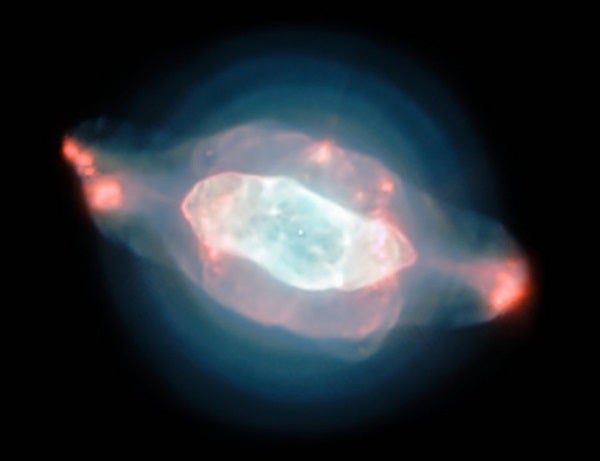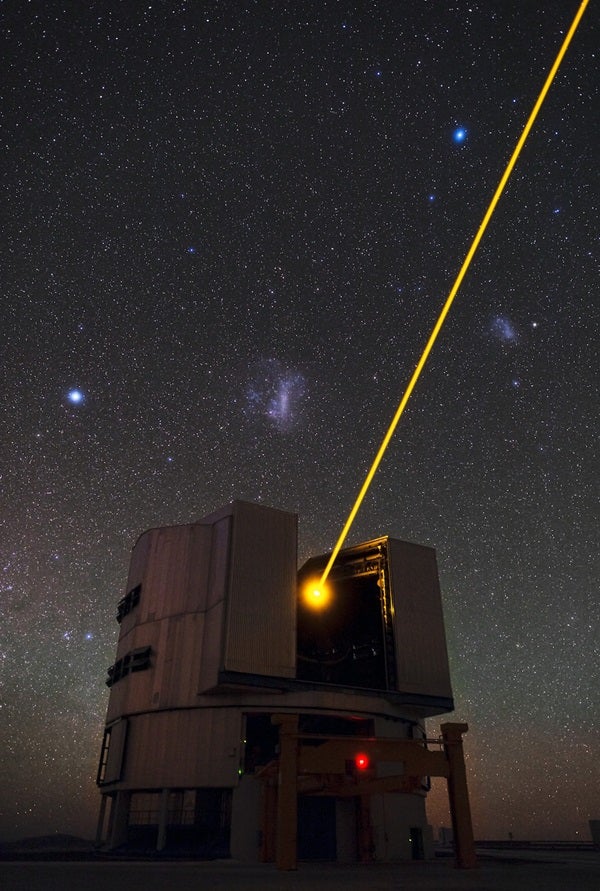Planetary nebulae are a poorly named group of cosmic objects. And that’s because planetary nebulae have nothing at all to do with planets.
Charles Messier discovered the first planetary nebula in 1764. But it was actually William Herschel, the discoverer of Uranus, who would go on to coin the term based on their round, planet-like appearance. Originally, Herschel believed that planetary nebulae were young, active stars trapped in contracting clouds of material. This material, he thought, would eventually coalesce to form planets around the star.
However, today we know that planetary nebulae are not young stars that are constructing planets. Instead, they are old stars in their final death throes, formed when a star like our Sun reaches the red giant phase of its life.
ESO/Digitized Sky Survey 2/N. Risinger
The Saturn Nebula — located about 5,000 light-years from Earth in the constellation Aquarius (The Water Bearer) — is a complex planetary nebula that contains many morphological features that scientists would greatly like to understand. This is why an international team of astronomers, led by Jeremy Walsh of the European Southern Observatory (ESO), used the Multi Unit Spectroscopic Explorer (MUSE) to peer inside the dazzling palls of the Saturn Nebula, producing the first detailed optical maps of a planetary nebula and revealing many of its intricate structures.
MUSE is installed on one of four Unit Telescopes that make up the Very Large Telescope at ESO’s Paranal Observatory in Chile. It’s an impressive piece of technology, and most of its power stems from the fact that MUSE not only creates a two-dimensional image of a target, but also gathers spectral data for each point in the image.
With this spectral information, the researchers can then filter the image by color, revealing information about the complex morphology of the object and its chemical composition. In the case of the Saturn Nebula, the team found a plethora of intricate structures, including a thin elliptical inner shell, a football-shaped outer shell, a spherical halo, and two well-known ansae — the Latin term for handles.
Most intriguingly, the researchers also found evidence of a mysterious wave-like structure within the dust of the Saturn Nebula. They found that just outside the rim of the inner shell, there is a notable drop in the amount of material, indicating it may be getting destroyed. Although the researchers are not sure what mechanism is destroying the dust and gas, the leading theory is that the inner shell is essentially a giant, expanding shock wave that is obliterating the dust as it travels outward.
Planetary nebulae are associated with low-mass, Sun-like stars. After spending billions of years converting hydrogen to helium in its core, a low-mass star will begin burning hydrogen in a shell around its core. When this happens, the temperature of the star drops significantly (giving it a red tint), and it balloons up to dozens of times its original size (making it a giant).
This video shows how the MUSE instrument turns a two-dimensional image into a three-dimensional depiction of the Saturn Nebula. By splitting each pixel into its component colors, researchers are able to tease out physical and chemical details that would otherwise be hidden.
By using MUSE to map the complicated structures within planetary nebulae, scientists hope reveal the role gas and dust plays in the lives (and deaths) of low-mass stars. Furthermore, astronomers can use the maps to better understand how planetary nebulae, like the Saturn Nebula, form such beautiful and strange structures.
Unfortunately for our distant descendants, the Saturn Nebula will not last forever. Over the course of a few tens of thousands of years, the nebula will continue to expand and cool so much that it will fade from our view entirely.
But then again, ten thousand years from now, we should have some pretty impressive telescopes.











